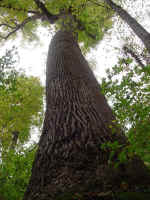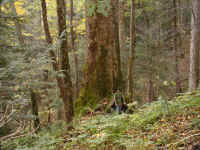For logistical reasons, I didn't attend the Forest Summit, but
over that
same time period I spent two and a half days hiking in the
smokies with
one of my roommates, which helped take some of the sting out of
missing
the gathering. This trip focused on the immediate vicinity of
Cosby
Campground and sites in the Greenbrier district park; both areas
are in
the northeastern part of the park on the Tennessee side.

Tuliptree:
Porters Bowl, Great Smoky Mountains NP, TN.
21'10" cbh x 161.0' Note the lack of balding on
the lower trunk indicating a relatively young tree.
Photograph by Richard Chewning
During that time period, fall colors were peaking in the middle
elevations. From a human perspective, sugar maple, sourwood, and
red
maple all excelled. Conversely, White ash, which last year at
the same
time displayed some of the best color in a less vibrant fall,
had already
lost all their leaves. Bitternut hickory bridged the gaps with
individuals ranging from fully green to nearly leafless. The
largest
diameter hickory encountered on the trip, see below, retained a
crown full
of brilliant yellow leaves.
Dense, even aged stands of tuliptree, typical of old farm fields
in the
region, cover Cosby Campground and surrounding gentle slopes.
Red maples
and black locusts occasionally compete with the tuliptrees, and
striped
maples and patches of small hemlocks fill in the understory. The
old
fields directly upslope of the campground end fairly abruptly at
the foot
of Camel Hump Mountain, which has a ridge-like form and a crest
around
4600'. On one slope of the mountain grows the former national
champion
sourwood, and Camel Hump Creek, which flows along the eastern
foot of the
mountain, supports a 22' cbh tuliptree. The slopes of the
mountain
nearest the campground host many cut chestnut stumps and other
indications
that the slopes were selectively cut in pre-park days, but old
sugar
maples still occur frequently in some of the steep coves on the
north side
of the mountain. A boulderfield stretches for at least a quarter
mile up
one of those coves and supports a canopy of sugar maple,
buckeye, and
yellowwood. Moss, rock stone-crop, and patches of walking fern
growing
directly on the boulders. Flanking the boulderfield, forests of
hemlock
and northern red oak with rhododendron understory grow out of
more visible
soil. Another one of the larger coves on the same slope of the
mountain
supported similar forest with fewer buckeyes, more silverbell,
and better
footing.
The search along the middle prong of the Middle Prong of the
Little Pigeon
River focus on a series of shallow, north facing coves at the
end of a
major ridge system coming off of Mount Guyot (6621'). The
parallel coves
rapidly drop the last few hundred feet down to the stream, but
lie on a
more gentle incline between approximately 2900' and 3300'. A
think
rhododendron layer covers the upper parts of the coves, but the
gently
inclined sections generally have an open understory. While a few
hemlocks
mix the buckeye-basswood-silverbell canopies of the centers of
the coves,
they more frequently associate with red maples on the small
dividing
ridges.
Porters Bowl is not a standardized name but rather a descriptive
title for
the area between Porters Creek and False Gap Prong at the north
end of
Porters Mountain in the Greenbrier section of the park. The main
ridgeline of Porters Mountain has an abrupt u-shaped fork where
the
mountain splits into two steep sided ridges. The land between
the ridges
consists of a broad flat area that leads into the steep, north
facing back
wall of the bowl, which is marked with a few steep coves. A
tuliptree
stand, probably the result of past farming although explicit
signs are not
as common as in adjacent areas, with a hemlock and buffalonut
understory
covers the floor of the bowl. Some of the small, steep, narrow
coves at
the end of one of the bordering ridges show a greater diversity
of
hardwoods in the canopy, but wind disturbances have a large
proportion of
those areas and led to extensive grapevine tangles. The coves of
the back
wall of the bowl also support a more diverse canopy of hardwoods
with a
mixture of sugar maple, bitternut hickory, white ash and
tuliptree over a
sparse yellowwood midstory. A trip to the area last year yielded
several
tuliptrees just over 150', one white ash over 140', and a
12'10" bitternut
hickory of the back wall.
Species Height Cbh Location
Basswood, White 123.8' NA Middle Prong Little Pigeon River
Buckeye, Yellow 131.6' 9'5" Middle Prong Little Pigeon
River
Buckeye, Yellow 137.1' 12'8" Middle Prong Little Pigeon
River
Buckeye, Yellow 145.6' 11'4" Middle Prong Little Pigeon
River
Devil's Walkingstick 53.4' 2'5.5" Middle Prong Little
Pigeon River
Hemlock, Eastern 139.6' 10'+ Middle Prong Little Pigeon River
Hemlock, Eastern 147.2' 17'5" Laurel Branch
Hickory, Bitternut 124.7'+ 12'6" Porters Bowl
Hickory, Bitternut ~134' 10'10" Camel Hump Mountain
Hickory, Bitternut 134.3' 10'9" Camel Hump Mountain
Hickory, Bitternut 142.9' 10'9" Porters Bowl
Maple, Sugar ~131' 9'11" Porters Bowl
Oak, Northern Red ~123' 16'9" Camel Hump Mountain
Sassafras 90.1' 5'10" Porters Bowl
Sassafras 97.2' 5'5" Porters Bowl
Silverbell, Mountain 115.6' 4'6" Middle Prong Little Pigeon
River
Tuliptree 132.8' 25'4" Middle Prong Little Pigeon River
Tuliptree 144.3' 10'+ Porters Bowl
Tuliptree 146.0' 18'3" Porters Bowl
Tuliptree 151.1' ~10' Porters Bowl
Tuliptree 156.2' ~7' Porters Bowl
Tuliptree 159.1' 16'2" Middle Prong Little Pigeon River
Tuliptree 161.0' 21'10" Porters Bowl
Walnut, Black 124.6' 5'7" Porters Creek Road
Walnut, Black 128.5' 7'2.5" Porters Creek
Yellowwood NA 8'7" Camel Hump Mountain
Yellowwood 85.0' 6'7" Camel Hump Mountain
At least one other buckeye reaches the upper 130's in the coves
along the
Middle Prong. The collection of tall buckeyes is not
particularly
unexpected given that three buckeyes over 140' had previously
been
measured in the generally area including Ramsey Prong. The shot
on the
tallest buckeye was not very good, but no other aspects of the
situation
suggest the height should be off.
Devil's walkingsticks also commonly reach large sizes in the
area. The
species raises an interesting point as to what all should be
included when
measuring height. Should the height listed only included the
permanent
parts of the tree, or should more ephemeral structures be
included. In
most cases, the issue is of little practical concern since
uppermost
leaves are rarely held vertically and contribute less than the
margin of
error to the total height. However, a bent devil's walkingstick
leaf
could easily add two feet, and in the case at hand, the fruit
cluster
probably added about a foot to the total height.
The first hemlock was measured out of convenience and is
probably
representative of hemlock heights in the series of coves. The
massive
new hemlock grows on a small flat where a small cove empties
into a minor
tributary of Laurel Branch. The tree has a hollow and enlarged
base, but
the flairing is restricted to the section of trunk below 4.5'.
The crown
starts only about 50' above the ground, so the slowly tapered
section of
trunk is fairly short. That fact makes me doubt this hemlock
will
challenge others for the greatest volume, but the tree still
accumulates
enough points to qualify as a national co-champion and a volume
record is
not out of the question.
A more careful measurement of mid-slope reduced the
circumference on the
large bitternut hickory by four inches relative to last years
measurement.
The largest sugar maples in Porters Bowl, as well as many other
species,
grow in an area at the foot of the back wall in an area that
probably only
had a few choice trees removed. Sugar maple, basswood, and
silverbell
dominate the rocky area although tuliptree and white ash are
also common.
With more looking a few sugar maples taller sugar maples and
several white
ash around 130' could be found.

Tuliptree: Middle Prong of the Little Pigeon River,
Great Smoky Mountains NP, TN.
25'4" cbh x 132.8' (broken crown)
Photograph by Richard Chewning
Before anyone gets two excited, the giant Middle Prong tuliptree
had its
crown ripped out by a storm, so the tree has no chance at a
volume record.
However, at one time the tree probably would have challenged for
the
volume title, but now must be content to be the largest chimney
in the
park, which it takes over from the 19'4" Buck Fork
sycamore. Standing
inside the trunk, daylight filters in from a few small holes
near the base
and from the open end at approximately 76.4'. The tree has one
bulge on
the downhill side that affects the circumference and a somewhat
irregular
tapering pattern along the length of the trunk. The tree grows
in the
vicinity of several yellow buckeyes, sugar maples, and small
hemlocks on a
bit of elevated ground where two coves intersect. Large
tuliptrees where
generally scarce in the coves, but the lower, steeper, more
rhododendron
choked sections were not explored.
The large tuliptree in Porters Bowl grows in the least disturbed
section
of the area described above. Several other large tuliptrees
where left on
the same low ridge. The tree appears quite
young, and, while not swollen
at the base, tapers quickly along the length of the trunk.
The circumference listed for the taller black walnut is a
measurement
listed from last year when the trees height was roughed out
around 125'.
Walnuts are naturalized but not native in the area.
Large yellowwoods are common in the boulder fields around the
base of Camel
Hump Mountain.
Jess Riddle
|